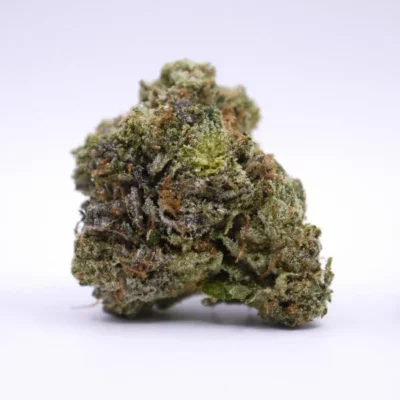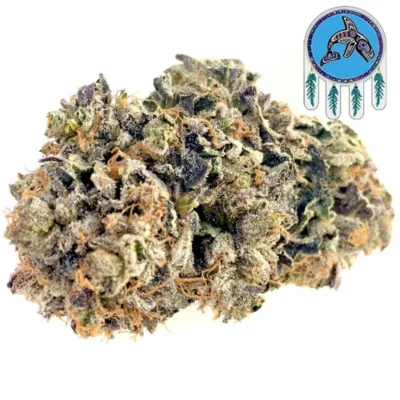cannabis, Flowers, Weed Strains
Exploring the Allure of Pink Tuna Strain Weed: A Comprehensive Guide
Exploring the Pink Tuna Strain Weed, a cannabis variety with a captivating allure unveils a world of sensory delight and therapeutic potential. Originating from the potent crossing of Pink Kush and Tuna Kush, this hybrid strain boasts a distinct aroma, flavour profile, and effects that have garnered immense popularity among cannabis enthusiasts. Its vibrant hues of pink and green, coupled with a pungent aroma reminiscent of its aquatic namesake, make it a standout among other strains.
Delving deeper into the allure of Pink Tuna Strain Weed reveals its multifaceted nature. With a high THC content averaging around 20-25%, this strain offers a potent experience characterized by euphoria, relaxation, and often a cerebral buzz. Its Indica-leaning genetics contribute to its renowned sedative properties, making it a favoured choice for alleviating stress, anxiety, and insomnia. However, its Sativa lineage ensures a balanced experience, keeping users mentally stimulated and creative.
A comprehensive guide to Pink Tuna Strain Weed wouldn’t be complete without exploring its cultivation and consumption nuances. Cultivating this strain requires attention to detail, with optimal conditions, including moderate temperatures and humidity levels. Whether indoors or outdoors, growers can expect a flowering period of approximately 8-10 weeks before reaping the rewards of resinous, trichome-covered buds. When it comes to consumption, users can enjoy Pink Tuna through various methods, including smoking, vaping, or infusing it into edibles, each offering a unique experience tailored to individual preferences.
In conclusion, the allure of Pink Tuna Strain Weed extends far beyond its captivating appearance, encompassing a spectrum of sensory experiences and therapeutic benefits. From its origins in the cannabis breeding world to its cultivation and consumption, this hybrid strain continues to fascinate and delight cannabis enthusiasts worldwide. Whether seeking relaxation after a long day or exploring the depths of creativity, Pink Tuna remains a versatile and cherished addition to the cannabis landscape.
Introduction to Pink Tuna Strain Weed
Pink Tuna Strain Weed is a potent and sought-after variety of cannabis that has gained popularity among both medical and recreational users. Named for its vibrant pink hues and powerful aroma, this strain is renowned for its relaxing and euphoric effects. With a high THC content, Pink Tuna delivers a strong punch that can alleviate stress, pain, and insomnia, making it a favourite among those seeking relief from various ailments. Its unique flavour profile combines hints of skunk, diesel, and sweet berries, creating a memorable sensory experience for users.
This hybrid strain is a cross between Pink Kush and Tuna Kush, resulting in a well-balanced combination of indica and sativa genetics. Its dense, resinous buds are characteristic of its indica lineage, while its uplifting cerebral effects are reminiscent of sativa strains. Pink Tuna’s versatility makes it suitable for consumption anytime, offering a relaxing body high without inducing sedation or lethargy. Whether used for medicinal purposes or recreational enjoyment, Pink Tuna Strain Weed stands out as a premium choice among cannabis enthusiasts seeking quality and potency.
The Origins and Genetics of Pink Tuna Strain
The Pink Tuna Strain Weed, a coveted variety among cannabis connoisseurs, has a lineage steeped in mystery and intrigue. Its origins can be traced back to combining two potent strains: Pink Kush and Tuna Kush. Pink Kush, renowned for its sweet aroma and potent effects, contributes to its indica dominance, while Tuna Kush, with its pungent scent and heavy resin production, adds depth to the genetic profile. This unique fusion yields a strain celebrated for its robust cannabinoid content and distinctive pink-hued buds, earning it the “Pink Tuna Strain.”
Understanding the genetics of the Pink Tuna Strain Weed unveils a fascinating journey of selective breeding and genetic manipulation. Breeders have meticulously crossed and backcrossed parent strains to enhance desirable traits such as flavour, potency, and resilience. Through generations of careful selection, the Pink Tuna Strain has emerged as a pinnacle of cannabis cultivation, embodying the best characteristics of its lineage while possessing its own distinct personality. Its popularity among enthusiasts and medical users alike speaks volumes to the success of its genetic makeup.
Beyond its allure and potency, the Pink Tuna Strain Weed is a testament to the boundless possibilities within cannabis breeding and genetics. Its existence highlights the artistry and science behind creating novel varieties that cater to diverse preferences and medicinal needs. As the cannabis industry evolves, understanding the origins and genetics of strains like Pink Tuna enriches our appreciation for the plant and fuels innovation and discovery in cultivation practices and therapeutic applications.
Aroma and Flavor Profile
The Pink Tuna Strain Weed boasts a distinctive aroma and flavour profile that sets it apart in the cannabis world. Its scent is an intricate blend of earthy notes with hints of diesel, complemented by a sweet undertone that lingers on the palate. Upon inhalation, its flavour unfolds with a robust combination of pine and skunk, delivering a rich and memorable experience for cannabis enthusiasts. The complexity of its aroma and flavour profile adds to the allure of the Pink Tuna Strain, making it a favourite among connoisseurs seeking a unique and satisfying cannabis experience.
Within the cannabis community, the Pink Tuna Strain Weed is celebrated not only for its potent effects but also for its exceptional aroma and flavour profile. Its distinct scent fills the room with a pungent yet inviting fragrance, teasing the senses with its complex layers of terpenes. As one indulges in its smooth smoke, the flavour profile reveals itself in full, offering a delightful journey of taste and sensation that captures the essence of this beloved strain.
For those seeking a sensory adventure, the Pink Tuna Strain Weed delivers an unparalleled experience with its captivating aroma and flavour profile. Each inhale invites you into a world of nuanced flavours, where earthy undertones dance harmoniously with sweet and spicy notes. Whether enjoyed alone or shared among friends, the Pink Tuna Strain stands as a testament to the artistry of cannabis cultivation, offering a sensory journey that delights the senses and elevates the cannabis experience to new heights.
Appearance and Characteristics
The Pink Tuna Strain Weed, a unique variety of cannabis, is distinguished by its striking appearance and distinctive characteristics. Its buds are adorned with vibrant hues of pink and purple, making it visually captivating and easily recognizable among other strains. Beyond its aesthetic appeal, the Pink Tuna Strain boasts potent effects that have garnered a loyal following among cannabis enthusiasts. Its high THC content delivers a potent euphoria coupled with deep relaxation, making it a popular choice for both recreational and medicinal users seeking relief from stress, pain, and insomnia.
In addition to its mesmerizing appearance and potent effects, the Pink Tuna Strain Weed possesses a complex aroma and flavour profile that further enhances its allure. Its fragrance combines notes of earthiness, sweetness, and hints of diesel, creating an enticing sensory experience for consumers. When smoked or vaporized, its flavour profile unfolds with a smooth and rich taste, often described as sweet and skunky with a touch of spice. This interplay of aroma and flavour adds depth to the overall cannabis experience, elevating the Pink Tuna Strain beyond mere potency to a multisensory delight.
Overall, the Pink Tuna Strain Weed stands out for its stunning appearance and exceptional characteristics that cater to a diverse range of preferences. Whether seeking relaxation after a long day or relief from chronic ailments, enthusiasts turn to this unique cannabis variety for its potent effects and enticing sensory profile. As its popularity continues to grow, the Pink Tuna Strain Weed remains a testament to the diverse and dynamic nature of the cannabis plant, offering a truly exceptional experience for connoisseurs and novices alike.
Growing Pink Tuna Strain: Tips and Techniques
For enthusiasts diving into cultivating Pink Tuna Strain weed, mastering the art requires a blend of skill and finesse. Cultivating this strain of cannabis demands meticulous attention to detail, starting from seed selection to harvesting. One crucial aspect is understanding the unique characteristics of the Pink Tuna Strain, known for its potent aroma and high THC content. Proper techniques tailored to its specific needs are key to nurturing robust plants that yield quality buds.
Environmental control is paramount when cultivating Pink Tuna Strain cannabis. Maintaining optimal temperature, humidity, and lighting ensures healthy growth and maximum potency. Also, employing suitable nutrients and supplements tailored to the strain’s requirements can enhance its development and yield. Regular monitoring and adjustment of these factors throughout the growth cycle contribute to producing top-quality Pink Tuna buds.
Harvesting Pink Tuna Strain weed at the peak of its potency requires careful timing and precision. Observing the plant’s trichomes and other indicators signals the ideal moment for harvesting, ensuring the preservation of its unique flavour profile and potent effects. Proper drying and curing techniques enhance the final product’s quality, unlocking the full potential of the Pink Tuna Strain’s distinct characteristics. With dedication and expertise, cultivating Pink Tuna cannabis can be rewarding for novice and experienced growers alike.
Medical Benefits of Pink Tuna Strain
The medical benefits of the Pink Tuna Strain weed, a strain of cannabis known for its distinctive aroma and potent effects, are increasingly being recognized within the realm of alternative medicine. This particular strain boasts a high concentration of cannabinoids, particularly THC and CBD, which have been shown to offer various therapeutic properties. For individuals seeking relief from chronic pain, the Pink Tuna Strain has emerged as a promising option, with its analgesic properties offering alleviation without the side effects often associated with traditional pain medications.
Moreover, Pink Tuna Strain cannabis has shown potential in alleviating symptoms of mental health disorders such as anxiety and depression. The calming and mood-enhancing effects of this strain can provide users with a sense of relaxation and tranquillity, making it a valuable tool for managing symptoms and improving overall well-being. Additionally, its sedative properties can aid those struggling with insomnia, promoting better sleep patterns and quality rest.
Furthermore, research suggests that Pink Tuna Strain weed may have neuroprotective properties, potentially offering benefits for individuals with neurodegenerative conditions such as Alzheimer’s disease and multiple sclerosis. Studies have indicated that certain compounds found in cannabis, including those present in Pink Tuna Strain, possess antioxidant and anti-inflammatory properties that could help protect brain cells from damage and slow down the progression of these debilitating conditions. As scientific understanding of cannabis continues to evolve, the medical potential of strains like Pink Tuna Strain is becoming increasingly apparent, offering hope for improved treatments and therapies in the future.
Psychoactive Effects and Potency
The psychoactive effects and potency of cannabis, particularly strains like Pink Tuna, illustrate the intricate interplay between chemical composition and user experience. Pink Tuna strain weed, renowned for its robust potency, delivers a potent blend of euphoria and relaxation. Its psychoactive profile, characterized by high levels of THC, the primary psychoactive compound in cannabis, induces a profound cerebral high coupled with physical sedation. Users often report a deeply calming experience, making it a popular choice for those seeking relief from stress and insomnia.
Understanding the psychoactive effects of cannabis entails delving into its diverse chemical composition and how different strains like Pink Tuna interact with the body’s endocannabinoid system. The potency of Pink Tuna underscores the importance of responsible consumption and dosage control to mitigate adverse reactions. While experienced users may appreciate its intense effects, novice consumers should approach with caution to avoid overwhelming psychoactive experiences.
In the realm of cannabis consumption, potency remains a crucial consideration for both recreational and medicinal users alike. The Pink Tuna strain exemplifies the variability in potency across cannabis cultivars, highlighting the need for informed decision-making regarding consumption preferences and desired effects. As research continues to unravel the complexities of cannabis and its psychoactive properties, users can make more informed choices, optimizing their cannabis experience while minimizing potential risks.
Cultural Impact and Popularity
The cultural impact and popularity of the Pink Tuna Strain Weed within the cannabis community are undeniable. As cannabis legalization spreads globally, enthusiasts are drawn to unique strains like Pink Tuna for their distinct aroma, flavour profile, and effects. This strain’s rise to prominence reflects a broader shift in attitudes towards cannabis, with consumers seeking more specialized and high-quality products.
Pink Tuna’s popularity extends beyond its recreational use, influencing various cultural aspects. From music to fashion, this strain has become a symbol of contemporary cannabis culture. Its presence in media, such as movies and music videos, further cements its status as an iconic strain. As cannabis continues to shed its stigma, strains like Pink Tuna play a significant role in shaping mainstream perceptions.
Moreover, Pink Tuna’s cultural impact highlights the evolving landscape of cannabis consumption. As more people embrace its therapeutic potential, discussions around medical cannabis and its various strains gain momentum. Pink Tuna stands as a testament to the diversity and innovation within the cannabis industry, illustrating how individual strains can captivate audiences and leave a lasting impression on popular culture.
Legal Status and Regulation
The legal status and regulation surrounding the cultivation and distribution of the Pink Tuna Strain Weed and cannabis vary significantly across different jurisdictions. In regions where cannabis is legalized for medicinal or recreational purposes, Pink Tuna Strain Weed, known for its potent effects and distinct aroma, falls under specific regulatory frameworks. These frameworks often include licensing requirements, quality control measures, and taxation systems to ensure consumer safety and generate revenue for the government. However, in areas where cannabis remains illegal, the cultivation and sale of Pink Tuna Strain Weed are subject to strict enforcement measures, leading to a thriving black market.
Furthermore, the legal landscape concerning Pink Tuna Strain Weed and cannabis is constantly evolving as governments reassess their policies and attitudes towards these substances. Recent years have witnessed a global trend towards cannabis legalization, driven by mounting evidence of its medicinal benefits and changing societal attitudes towards recreational use. This shift has prompted lawmakers to introduce legislation aimed at regulating the production, distribution, and consumption of cannabis products, including the Pink Tuna Strain Weed, in a manner that balances public health concerns with individual liberties and economic opportunities.
As legalization efforts gain momentum, stakeholders, including policymakers, industry players, and advocacy groups, continue to engage in debates surrounding the legal status and regulation of Pink Tuna Strain Weed and cannabis. Key issues under consideration include the establishment of licensing requirements for growers and retailers, the implementation of quality control standards to ensure product safety, and the development of taxation schemes to fund public health initiatives and drug education programs. By addressing these challenges comprehensively and collaboratively, jurisdictions can create a regulatory framework that maximizes the benefits of cannabis legalization while minimizing potential harm to society.
The Future of Pink Tuna Strain Weed
As the cannabis industry continues to evolve, the future of Pink Tuna Strain Weed appears promising. This unique strain, known for its potent effects and distinct aroma, has captured the attention of both recreational and medicinal users alike. With advancements in cultivation techniques and genetic research, we can anticipate even greater refinement and consistency in the production of Pink Tuna Strain Weed. This could lead to enhanced therapeutic benefits and a more enjoyable consumer experience.
Moreover, as legalization efforts gain momentum worldwide, the market for Pink Tuna Strain Weed is expected to expand significantly. Increased access to this sought-after variety may foster innovation in product development, from edibles to concentrates, catering to diverse consumer preferences. Furthermore, the potential integration of Pink Tuna Strain Weed into mainstream culture could challenge stereotypes and promote acceptance of cannabis as a legitimate industry.
However, alongside these opportunities, challenges such as regulatory hurdles and quality control measures must be addressed to ensure the sustainable growth of the Pink Tuna Strain Weed market. Collaborative efforts between industry stakeholders, policymakers, and researchers will be crucial in shaping the future trajectory of this beloved cannabis strain. With careful planning and strategic investments, Pink Tuna Strain Weed could emerge as a cornerstone of the burgeoning cannabis market, offering both economic benefits and therapeutic relief to millions around the globe.



